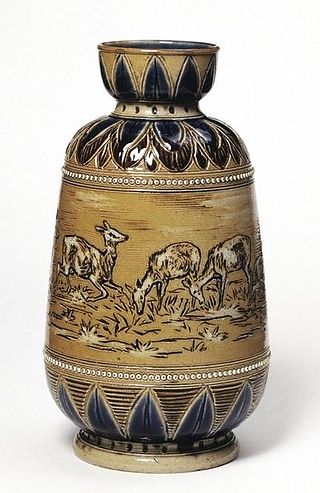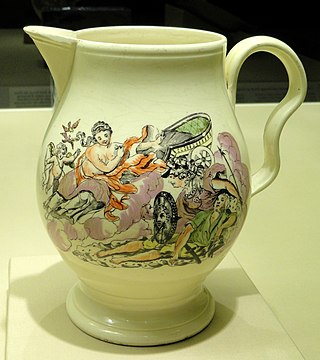
William Moorcroft (1872-1945) was an English potter who founded the Moorcroft pottery business. [1]

William Moorcroft (1872-1945) was an English potter who founded the Moorcroft pottery business. [1]
He was born in Burslem, Staffordshire. He studied art at Burslem then in London and Paris. [2]

Moorcroft married Florence Nora Fleay Lovibond (1879-1926) in 1913. They had a daughter, Beatrice (1914) and a son, Walter (1917). After the death of his first wife, he married Marian Lasenby, a relative of Arthur Lasenby Liberty, the founder of the department store Liberty & Co.
In 1897 Staffordshire pottery manufacturers James Macintyre & Co. Ltd employed 24-year-old William Moorcroft as a designer, and within a year he was put in full charge of the company's art pottery studio. Early in his employment at Macintyre's, William Moorcroft created designs for the company's Aurelian Ware range of high-Victorian pottery, which had transfer-printed and enamelled decoration in bold red, blue and gold colours. Moorcroft developed highly lustred glazes and used oriental shapes and decorations. Some of his techniques were closely guarded trade secrets.
He then developed his famous Florian Ware, with heavy slip and a translucent glaze which produces brilliance of colour. [3] Florian Ware was influenced by art nouveau. It was decorated entirely by hand, with the design outlined in trailed slip using a technique known as tubelining. Florian Ware was a great success and won him a gold medal at the World's fair, the St. Louis International Exhibition in 1904. Unusually at that time, he adopted the practice of signing his name, or his initials, on nearly all the pottery he designed, the production of which he personally oversaw. In due course the extent to which his success had overshadowed Macintyre's other manufacturing activities resulted in resentment on the part of his employers, culminating in their decision in 1912 to close down his studio.
In 1913, William Moorcroft then set up his own factory at Cobridge with staff from Macintyres, and backed by a financial arrangement with Liberty & Co of London, The business succeeded. Much of the output was sold through Liberty & Co. [4] and Tiffany in New York City. In 1928 Queen Mary made him "Potter to the Queen" through a Royal Warrant, which was stamped on the pottery. His son, Walter joined the company when he was twenty, and took over the management of the pottery in 1945 just before William's death.

Josiah Wedgwood was an English potter, entrepreneur and abolitionist. Founding the Wedgwood company in 1759, he developed improved pottery bodies by systematic experimentation, and was the leader in the industrialisation of the manufacture of European pottery.

Pottery is the process and the products of forming vessels and other objects with clay and other raw materials, which are fired at high temperatures to give them a hard and durable form. The place where such wares are made by a potter is also called a pottery. The definition of pottery, used by the ASTM International, is "all fired ceramic wares that contain clay when formed, except technical, structural, and refractory products". End applications include tableware, decorative ware, sanitaryware, and in technology and industry such as electrical insulators and laboratory ware. In art history and archaeology, especially of ancient and prehistoric periods, pottery often means vessels only, and sculpted figurines of the same material are called terracottas.

Faience or faïence is the general English language term for fine tin-glazed pottery. The invention of a white pottery glaze suitable for painted decoration, by the addition of an oxide of tin to the slip of a lead glaze, was a major advance in the history of pottery. The invention seems to have been made in Iran or the Middle East before the ninth century. A kiln capable of producing temperatures exceeding 1,000 °C (1,830 °F) was required to achieve this result, the result of millennia of refined pottery-making traditions. The term is now used for a wide variety of pottery from several parts of the world, including many types of European painted wares, often produced as cheaper versions of porcelain styles.

Pottery and porcelain, is one of the oldest Japanese crafts and art forms, dating back to the Neolithic period. Kilns have produced earthenware, pottery, stoneware, glazed pottery, glazed stoneware, porcelain, and blue-and-white ware. Japan has an exceptionally long and successful history of ceramic production. Earthenwares were made as early as the Jōmon period, giving Japan one of the oldest ceramic traditions in the world. Japan is further distinguished by the unusual esteem that ceramics holds within its artistic tradition, owing to the enduring popularity of the tea ceremony.

Thomas Whieldon was an English potter who played a leading role in the development of Staffordshire pottery.

The Staffordshire Potteries is the industrial area encompassing the six towns Burslem, Fenton, Hanley, Longton, Stoke and Tunstall, which is now the city of Stoke-on-Trent in Staffordshire, England. North Staffordshire became a centre of ceramic production in the early 17th century, due to the local availability of clay, salt, lead and coal.

Slipware is pottery identified by its primary decorating process where slip is placed onto the leather-hard (semi-hardened) clay body surface before firing by dipping, painting or splashing. Slip is an aqueous suspension of a clay body, which is a mixture of clays and other minerals such as quartz, feldspar and mica. The slip placed onto a wet or leather-hard clay body surface by a variety of techniques including dipping, painting, piping or splashing. Slipware is the pottery on which slip has been applied either for glazing or decoration. Slip is liquified clay or clay slurry, with no fixed ratio of water and clay, which is used either for joining pottery pieces together by slip casting with mould, glazing or decorating the pottery by painting or dipping the pottery with slip.

Creamware is a cream-coloured refined earthenware with a lead glaze over a pale body, known in France as faïence fine, in the Netherlands as Engels porselein, and in Italy as terraglia inglese. It was created about 1750 by the potters of Staffordshire, England, who refined the materials and techniques of salt-glazed earthenware towards a finer, thinner, whiter body with a brilliant glassy lead glaze, which proved so ideal for domestic ware that it supplanted white salt-glaze wares by about 1780. It was popular until the 1840s.

Islamic pottery occupied a geographical position between Chinese ceramics, and the pottery of the Byzantine Empire and Europe. For most of the period, it made great aesthetic achievements and influence as well, influencing Byzantium and Europe. The use of drinking and eating vessels in gold and silver, the ideal in ancient Rome and Persia as well as medieval Christian societies, is prohibited by the Hadiths, with the result that pottery and glass were used for tableware by Muslim elites, as pottery also was in China but was much rarer in Europe and Byzantium. In the same way, Islamic restrictions greatly discouraged figurative wall painting, encouraging the architectural use of schemes of decorative and often geometrically patterned titles, which are the most distinctive and original specialty of Islamic ceramics.

Wedgwood is an English fine china, porcelain and luxury accessories manufacturer that was founded on 1 May 1759 by the potter and entrepreneur Josiah Wedgwood and was first incorporated in 1895 as Josiah Wedgwood and Sons Ltd. It was rapidly successful and was soon one of the largest manufacturers of Staffordshire pottery, "a firm that has done more to spread the knowledge and enhance the reputation of British ceramic art than any other manufacturer", exporting across Europe as far as Russia, and to the Americas. It was especially successful at producing fine earthenware and stoneware that were accepted as equivalent in quality to porcelain but were considerably cheaper.

Royal Doulton is an English ceramic and home accessories manufacturer that was founded in 1815. Operating originally in Vauxhall, London, and later moving to Lambeth, in 1882 it opened a factory in Burslem, Stoke-on-Trent, in the centre of English pottery. From the start, the backbone of the business was a wide range of utilitarian wares, mostly stonewares, including storage jars, tankards and the like, and later extending to drain pipes, lavatories, water filters, electrical porcelain and other technical ceramics. From 1853 to 1901, its wares were marked Doulton & Co., then from 1901, when a royal warrant was given, Royal Doulton.
W. Moorcroft Limited is a British art pottery manufacturer specialising in richly decorated earthenware. based at Burslem in Stoke-on-Trent, England. The company was founded by William Moorcroft in 1913.

Frederick Hurten Rhead (1880–1942) was a ceramicist and a major figure in the Arts and Crafts movement. A native of England, worked as a potter in the United States for most of his career. In addition to teaching pottery techniques, Rhead was highly influential in both studio and commercial pottery. He worked for the Roseville Pottery, established his own Rhead Pottery (1913–1917), and in 1935 designed the highly successful Fiesta ware for Homer Laughlin China Company.

Mintons was a major company in Staffordshire pottery, "Europe's leading ceramic factory during the Victorian era", an independent business from 1793 to 1968. It was a leader in ceramic design, working in a number of different ceramic bodies, decorative techniques, and "a glorious pot-pourri of styles - Rococo shapes with Oriental motifs, Classical shapes with Medieval designs and Art Nouveau borders were among the many wonderful concoctions". As well as pottery vessels and sculptures, the firm was a leading manufacturer of tiles and other architectural ceramics, producing work for both the Houses of Parliament and United States Capitol.

The Wedgwood Institute is a large red-brick building that stands in Queen Street, in the town of Burslem, Stoke-on-Trent, Staffordshire, England. It is sometimes called the Wedgwood Memorial Institute, but it is not to be confused with the former Wedgwood Memorial College in Barlaston. It achieved listed building status in 1972.

Charles Vyse, was an English studio potter, noted for producing colourful figurines of characters seen on London streets.

Thomas Toft was an English potter working in the Staffordshire Potteries during the 17th century. He and his family are known for large earthenware plates heavily decorated by slip-trailing, often in several colours. Work in this style, even by other makers, is known as Toft ware.
The Rye Pottery is a pottery in Rye, East Sussex, England, known as the Cadborough Pottery or "Rye Pottery" from its beginnings in c. 1834 to 1876, and Belle Vue Pottery from 1869 until it closed in 1939. It was revived as the "Rye pottery" in 1947 by the brothers Walter and John Cole, who became known for their tinglazed wares. During the 19th and early 20th centuries it produced earthenware in a distinctive style of sprigged applied relief decoration, sometimes supplemented by inscriptions using printer's type, which was marketed as "Sussex Rustic Ware". Often the texture of surfaces imitated tree bark. From c. 1840 to 1930 it was owned by members of the Mitchell family.

Shelley Potteries, situated in Staffordshire, was earlier known as Wileman & Co. which had also traded as The Foley Potteries. The first Shelley to join the company was Joseph Ball Shelley in 1862 and in 1896 his son Percy Shelley became the sole proprietor, after which it remained a Shelley family business until 1966 when it was taken over by Allied English Potteries. Its china and earthenware products were many and varied although the major output was table ware. In the late Victorian period the Art Nouveau style pottery and Intarsio ranges designed by art director Frederick Alfred Rhead were extremely popular but Shelley is probably best known for its fine bone china “Art Deco” ware of the inter-war years and post-war fashionable tea ware.

William Greatbatch was a noted potter at Fenton, Staffordshire, from the mid-eighteenth to the beginning of the nineteenth centuries. Fenton was one of the six towns of the Staffordshire Potteries, which were joined in the early 20th century to become the city of Stoke-on-Trent in Staffordshire, England.